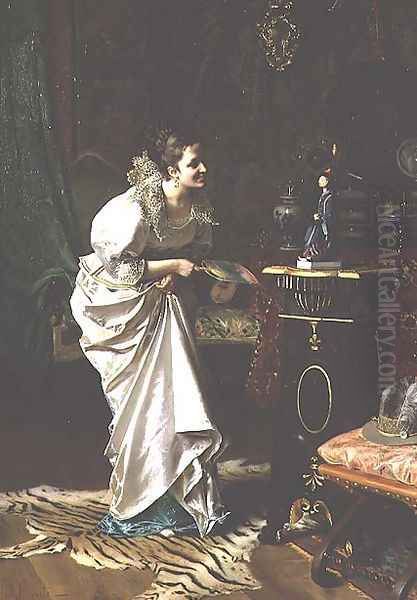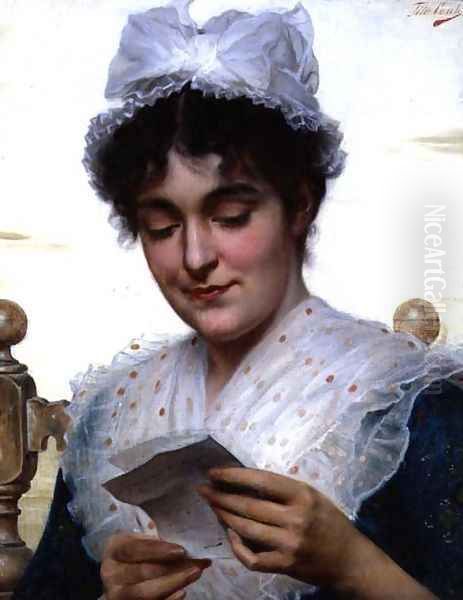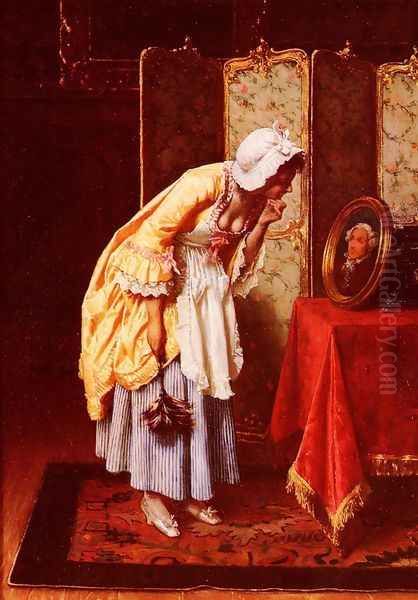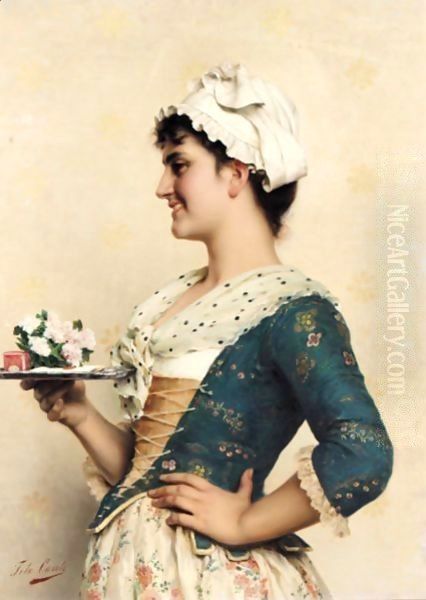Tito Conti (1842–1924) stands as a significant figure in late 19th-century Italian art. Born and primarily active in Florence, Conti carved a niche for himself through his exceptional technical skill, particularly in portraiture and genre scenes. He possessed a remarkable ability to capture the subtle nuances of human emotion, often presenting his subjects with an air of elegance and charm. His work is characterized by meticulous attention to detail, a profound understanding of human anatomy, and a distinctive personal style that resonated with the tastes of his time.
Early Life and Artistic Formation
Born in the vibrant artistic hub of Florence in 1842, Tito Conti displayed a natural inclination towards the visual arts from a young age. Recognizing his burgeoning talent, he sought formal training to hone his skills. In 1855, he enrolled in the prestigious Florence Academy of Fine Arts (Accademia di Belle Arti di Firenze). This institution provided him with a rigorous grounding in classical principles, drawing, and painting techniques. During these formative years, his work often reflected a classical sensibility, emphasizing grace, harmony, and a delicate rendering of the human form.
Conti's education instilled in him a deep respect for anatomical accuracy and refined craftsmanship, traits that would remain hallmarks of his work throughout his career. He emerged from the Academy with a solid technical foundation, ready to make his mark on the Italian art scene. His official debut came in 1861 when he participated in the First National Exhibition held in Florence, an event that showcased the artistic talents emerging across the newly unified Italy.
The Ascendancy of a Portraitist
Following his academic training, Conti quickly gained recognition, particularly for his portraiture. He demonstrated an uncanny ability to not only capture a physical likeness but also to imbue his subjects with personality and psychological depth. His portraits, often depicting elegant women from the upper echelons of society, were admired for their sophisticated execution and intimate portrayal. He masterfully rendered the textures of luxurious fabrics, the intricate details of hairstyles and jewelry, and the subtle play of light on skin, creating images that were both lifelike and aesthetically pleasing.

A quintessential example of his prowess in this genre is the celebrated work An Italian Beauty. This painting exemplifies Conti's strengths: the subject, a young woman, is presented with striking vividness and realism. Her gaze engages the viewer directly, while Conti's delicate brushwork captures the softness of her hair, the warmth of her expression, and the intricate details of her attire. The painting radiates a sense of youthful charm and vitality, showcasing Conti's skill in making his subjects feel present and alive. His mastery of anatomy is evident in the confident rendering of form, while his rich color palette adds to the overall allure.
Transition to Genre Painting and Thematic Richness
Around 1870, Tito Conti's artistic focus began to shift, moving increasingly towards genre painting, although he never entirely abandoned portraiture. This period marked a phase of great maturity and prolific output in his career. His genre scenes often explored themes of everyday life, historical settings, and romantic encounters, frequently featuring figures dressed in elaborate period costumes, particularly from the 17th and 18th centuries. These works allowed Conti to combine his skill in figure painting with narrative elements and rich environmental details.
His genre paintings often carried a sense of narrative charm and sometimes a lighthearted, even flirtatious, atmosphere. He excelled at depicting intimate moments – courtship rituals, quiet contemplation, shared glances – conveying emotions subtly through gesture and expression. These works reflected the societal interests and sentiments of the time, often celebrating beauty, love, and the picturesque aspects of history or contemporary life. They were highly sought after by collectors who appreciated their decorative qualities and engaging subject matter.
Conti's interest sometimes extended to incorporating elements of exoticism, reflecting a broader European fascination with non-Western cultures during the 19th century, often referred to as Orientalism. A notable example is the painting titled Paying Her Respects to His High Mightiness. This work depicts a European woman, clad in 17th-century attire, bowing respectfully before a figure presumed to be a Chinese official. The inclusion of Oriental objects and the cross-cultural encounter theme highlight Conti's engagement with popular trends and his ability to weave intriguing narratives within his detailed compositions.
Artistic Style, Technique, and the "Keepsake" Tradition
Tito Conti's style is firmly rooted in academic tradition, emphasizing draftsmanship, careful composition, and a high degree of finish. His brushwork is typically refined and controlled, allowing for meticulous rendering of detail without sacrificing the overall harmony of the piece. He possessed a keen eye for color, employing a rich and often vibrant palette to enhance the mood and realism of his scenes. His ability to depict different textures – the sheen of silk, the softness of velvet, the luster of pearls, the warmth of skin – was particularly admired.

Conti's work found a comfortable place within the late 19th-century "keepsake" or "cabinet painting" tradition. This style, popular among bourgeois collectors, favored smaller-scale paintings characterized by intricate detail, sentimental or charming subjects, and a high level of technical polish. These works were often intimate, designed for close viewing in domestic settings. Conti was considered one of the foremost practitioners of this style in Italy. His depictions of beautiful women, often in luxurious interiors adorned with flowers, tapestries, and objets d'art, perfectly catered to the tastes of this market.
While adhering to academic principles, Conti's work often possessed a certain vivacity and charm that distinguished it. His female figures, whether elegant ladies or charming maids, were rendered with sensitivity and grace. There was often a subtle theatricality to his compositions, inviting the viewer into a carefully constructed world of beauty and refinement. This combination of technical brilliance and appealing subject matter secured his popularity throughout his career.
Context: Florence, Contemporaries, and Influence
Tito Conti operated within the dynamic artistic environment of late 19th-century Florence. While the city was also the cradle of the revolutionary Macchiaioli movement – whose members like Telemaco Signorini, Silvestro Lega, and Giovanni Fattori championed painting en plein air and a looser, more immediate style based on patches (macchie) of color and light – Conti largely remained aligned with the more traditional, academic approach favored by the market and institutions. His detailed finish and historical or romantic themes stood in contrast to the Macchiaioli's focus on contemporary Tuscan landscapes and peasant life.
However, Conti was not isolated. He was part of a circle of artists often referred to as "costume painters" who specialized in historical genre scenes. He worked alongside contemporaries such as Edoardo Gelli, and it's known that these artists sometimes shared models and studio props, indicating a degree of collegial interaction within this specific niche of the Florentine art world. His work can also be seen in the broader context of successful European academic and society painters of the era, such as the Paris-based Italian expatriates Giovanni Boldini and Federico Zandomeneghi, or others like Vittorio Matteo Corcos, who also excelled in elegant depictions of modern life and feminine beauty.
Conti's influence extended through his teaching. His most notable student was Arturo Ricci (1854-1919), who initially followed closely in his master's footsteps, painting similar historical genre scenes with meticulous detail. Ricci eventually developed his own highly successful career, becoming one of Europe's leading artists in this popular style, arguably even surpassing his teacher in international fame for these specific types of compositions.

It is important to distinguish Tito Conti (1842-1924) from the earlier Florentine painter Santi di Tito (1536-1603). Some sources mistakenly conflate the two or misattribute collaborations. The collaborations mentioned in some contexts involving Francesco Bartolozzi and Federico Barocci pertain to the Renaissance/Mannerist artist Santi di Tito, not the 19th-century Tito Conti discussed here. While Conti worked within a long tradition of Florentine art, drawing inspiration perhaps from Renaissance masters like Titian (Tiziano Vecellio) or his contemporary Giorgione in terms of color and composition, his direct artistic lineage and context lie firmly in the academic and genre traditions of the later 19th century, influenced perhaps by earlier Romantics like Francesco Hayez but distinct in his polished style.
Critical Reception, Market Success, and Legacy
Tito Conti enjoyed considerable success and recognition during his lifetime. His technical skill was widely praised, and his paintings were popular with both Italian and international collectors. His ability to create beautiful, engaging images that combined historical nostalgia with contemporary sensibilities appealed to the tastes of the burgeoning middle and upper classes. His works were frequently exhibited and fetched good prices on the art market.
However, his work was not without its critics. The influential 19th-century critic James Jackson Jarves, while acknowledging Conti's technical brilliance, offered a nuanced critique. Jarves felt that Conti sometimes became too preoccupied with the execution, the meticulous rendering of details, fabrics, and accessories, potentially at the expense of the deeper substance or emotional core of the subject. He famously remarked that Conti's work was almost "painted too well," suggesting that if his undeniable creative power were more focused on the primary theme rather than the surrounding embellishments, he could have ranked among the greatest painters of his time. This critique highlights a recurring debate in art history regarding the balance between technical virtuosity ("how" something is painted) and conceptual or emotional depth ("what" is being conveyed).
Despite such criticisms, Conti's popularity endured. His paintings entered significant private collections, such as that of the English philanthropist Thomas Holloway, who acquired An Italian Beauty. This painting later achieved a notable price of $27,500 at auction, indicating the continued market value of Conti's work.
Today, Tito Conti's paintings are held in the collections of numerous prestigious museums around the world. These include Italian institutions like the Capodimonte Museum in Naples, the Pinacoteca di Brera in Milan, and the Galleria Nazionale d'Arte Moderna in Rome, as well as international museums such as the Museo Nacional de Bellas Artes in Buenos Aires, Argentina. His works continue to be appreciated for their charm, elegance, and masterful technique, offering a window into the artistic tastes and social milieu of late 19th-century Italy.
Conclusion

Tito Conti remains a compelling figure in the landscape of 19th-century Italian art. From his rigorous training at the Florence Academy to his successful career as a painter of portraits and genre scenes, he consistently demonstrated exceptional technical skill and a refined aesthetic sensibility. His evolution from a more classical style to a specialist in detailed, often romantic or historical genre scenes reflects both his personal artistic journey and the prevailing tastes of his era. While sometimes criticized for an overabundance of detail, his ability to capture beauty, emotion, and the allure of bygone eras secured his popularity with collectors and the public. As a master of the "keepsake" tradition, a skilled portraitist, and an influential teacher, Tito Conti left behind a legacy of elegant, meticulously crafted works that continue to charm viewers today, representing a significant facet of Florentine art in the decades following Italian unification.